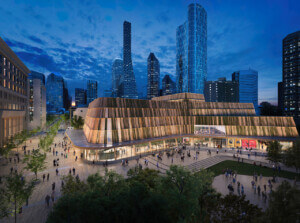Timber was the obvious choice for the Wood Innovation and Design Centre (WIDC). This sturdy carbon-storing material is increasingly an alternative to concrete or steel in mid-rises and “plyscrapers.” For a province-owned building in Prince George, British Columbia, mandated to use local products, Michael Green Architecture (MGA) won the competition with a “dry structure” using no concrete slabs above grade (except one small vibration-controlling roof panel, notes project manager Mingyuk Chen) and deploying wood everywhere from posts and beams to mullions.
- Facade Manufacturer
Guardian Industries Corp.; Brisco Wood Preservers; Kawneer - Architects
Michael Green Architecture - Facade Installer
PCL Constructors Westcoast, Inc. (contractor) - Facade Consultants
RDH Building Engineering, Ltd. (building envelope); Equilibrium Consulting, Inc. (structural engineer) - Location
Prince George, BC (Canada) - Date of Completion
2014 - System
Cross-laminated timber (CLT) - Products
Columns and timber by Structurlam; facade and glazing by Guardian Industries Corp., Brisco Wood Preservers, Kawneer; Blinds and shades by Hunter Douglas Architectural
The 97-foot WIDC was North America’s tallest all-wood building when it opened in 2014. A site-specific code amendment allowed nonresidential construction for this project, recalls Chen. Its lowest three floors house programs of the University of Northern British Columbia and Emily Carr University, with wood-industry offices above.
Materials include cross-laminated timber (CLT), mainly Douglas fir, for floor panels, shear walls, and core shafts and stairs; Douglas fir glulam for columns and most beams; laminated veneer lumber for the window mullions, entrance canopy, and feature stairs; parallel-strand lumber for load-transferring beams; and Western red cedar, charred or natural, for cladding. The facade, notes principal Graham Finch of envelope specialists RDH, uses Kawneer curtain-wall units of aluminum veneer attached to wood framing, with high-performance triple glazing and irregular patterns varying from solar-gain-maximizing southern fenestration to prefabricated structural insulated panels on the north.
CLT is counterintuitively fire-resistant, Chen notes, needing no chemical treatment; if exposed to fire, it forms a carbon “sacrificial layer” slowing the char rate. Onsite dampness mitigation poses minimal challenge, Finch adds, noting that timber construction is widespread in Europe and ready for prime time here. “It forces you to go back to first principles and rethink…. It’s not that it’s hard; it’s new, it’s unique,” he says. Growing the WIDC’s materials, he adds, took Canada’s forests under three minutes.
RDH Managing Principal/Senior Building Science Specialist Brian Hubbs will be speaking about “Facades for Wood High-Rises” at Facades+ New York City on April 6+7.










